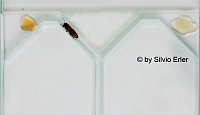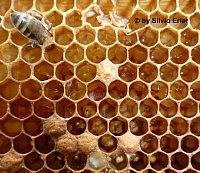Self-medication behaviour against parasites and pathogens
Honeybees, as many other insects, fight parasite and pathogen attacks by means of their innate immune system as well as mechanical and behavioural defence mechanisms. The classical innate immune system uses melanisation, apoptosis and the release of antimicrobial peptides to control or kill honeybee infections (Evans et al., 2006).
Behavioural immune defence, also known as ‘social immunity’ (Cremer et al., 2007), summarized a variety of mechanisms preventing, controlling and reducing parasite and pathogen infections. Increased grooming and hygienic behaviour are well known for many bee diseases (e.g., Varroa destructor, American foulbrood and chalk brood). Another, and more flexible defence behaviour is the collection of antibiotic (means a combination of antiviral, antimicrobial and antifungal) plant substances used for nutrition (pollen, nectar) and hive maintenance (resin).
Plenty of studies focussed on the antibiotic activity of propolis and resin. We here focus on the carbohydrate resource of bee colonies. Floral nectar collected from a variety of plant species processed and stored in the honeybee hive might be a useful in-hive pharmacy preventing and decreasing brood infections and other bee diseases. The antibiotic activity of honey is contributed by its floral origin and mainly attributable to plant secondary metabolites.
1) Pathogen-associated self-medication behaviour:

In a first study we were able to show the first pathogen-associated self-medication behaviour in Nosema ceranae infected honeybee workers. In a Y-maze assay workers bees (sick and healthy) could choose between four different honeys in a pair-wise design. Infected workers preferentially selected a single honey type much more with increasing infection intensity compared to the other three tested honeys. This honey also reduced significantly Nosema spore loads in the gut of infected bees and showed to have the strongest antimicrobial activity, tested in an in vitro bacterial assay.
2) Highly efficient diversity of honey stores

Honeybee brood diseases (American and European foulbrood) may also be controlled by specific antimicrobial honey from the diversity of the stored honey in the hive. Several mono- and one polyfloral honey were tested for their antimicrobial activity against a set of American and European foulbrood causing and associated bacterial strains. The results of using a high-throughput in vitro cell growth assay revealed honey type and pathogens strain specific interactions for the different monofloral honey types. Comparing the results of the sugar control and honey samples showed that the osmotic activity of the sugar cannot explain the observed pattern.
Both studies indicate that the diversity of honeys in the honey stores of a colony may be highly adaptive for its ‘social immunity’ against the highly diverse suite of pathogens and parasites encountered in nature. As nurse bees feed not only the larvae but also other colony members, this self-medication behaviour might be a highly adaptive form of therapeutic and/or prophylactic medication at both the individual and the colony level.



